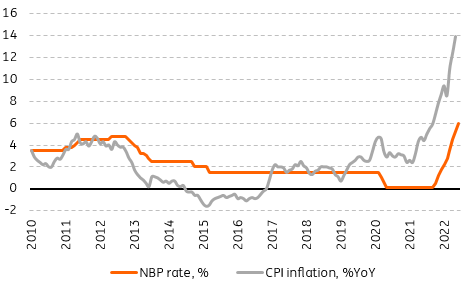
Despite a further increase in inflation, the NBP's Monetary Policy Committee decided not to increase the scale of monetary tightening, which could have resulted from a marked deterioration in industrial sentiment (PMI in May fell below the 50-point threshold separating the recovery phase from the economic slowdown). Nevertheless, the cycle of rate increases remains aggressive. In the post-meeting press release, the Council admitted for the first time that price increases in Poland are being driven by continuing high demand, allowing companies to pass on cost increases to consumers. Policymakers are starting to recognize that domestic factors are also playing their part in elevated inflation.
In our view, one of the main reasons for significant interest rate increases is not only the high level of CPI inflation (according to flash estimates, it came to 13.9% YoY in May) but also increasingly clear signals of mounting secondary effects - rapidly rising core inflation - and a price-wage spiral (wage growth accelerated to 14.1%YoY in May). Concerns about the de-anchoring of inflation expectations are also intensifying. The increase in producer prices in April reached 23.3%YoY, so there is ample room for the mentioned pass-through of rising costs to final prices.
Inflation and the NBP rate

Source; GUS, NBP.
We estimate that the coming months will bring further increases in core inflation, with CPI reaching a local peak in the 15-20% range in the fourth quarter of the year. The macroeconomic environment remains conducive to sustained elevated inflation. Past increases in energy, transport, material and labor costs are spilling over into the final prices of an increasing number of goods and services. This is supported by still robust demand, driven by rising incomes due to the tight labour market and fiscal expansion. An important risk to inflation's path in 2023 is the scale of future increases in administered prices and decisions regarding the Anti-Inflation Shield.
Price growth as high as it is now is starting to become self-reinforcing. Containing it requires a decisive tightening of monetary policy, especially as the expansionary fiscal policy limits the restrictiveness of the policy mix. We expect further decisive moves from the MPC in the coming months and maintain our scenario of an increase in the reference rate in the current cycle to 8.5%. The next rate hike will come in July, when we will also learn about the latest NBP projections.
Disclaimer: This publication has been prepared by the Economic and Financial Analysis Division of ING Bank N.V. (“ING”) solely for information purposes without regard to any ...
more
Disclaimer: This publication has been prepared by the Economic and Financial Analysis Division of ING Bank N.V. (“ING”) solely for information purposes without regard to any particular user's investment objectives, financial situation, or means. ING forms part of ING Group (being for this purpose ING Group NV and its subsidiary and affiliated companies). The information in the publication is not an investment recommendation and it is not investment, legal or tax advice or an offer or solicitation to purchase or sell any financial instrument. Reasonable care has been taken to ensure that this publication is not untrue or misleading when published, but ING does not represent that it is accurate or complete. ING does not accept any liability for any direct, indirect or consequential loss arising from any use of this publication. Unless otherwise stated, any views, forecasts, or estimates are solely those of the author(s), as of the date of the publication and are subject to change without notice.
The distribution of this publication may be restricted by law or regulation in different jurisdictions and persons into whose possession this publication comes should inform themselves about, and observe, such restrictions.
Copyright and database rights protection exists in this report and it may not be reproduced, distributed or published by any person for any purpose without the prior express consent of ING. All rights are reserved. ING Bank N.V. is authorised by the Dutch Central Bank and supervised by the European Central Bank (ECB), the Dutch Central Bank (DNB) and the Dutch Authority for the Financial Markets (AFM). ING Bank N.V. is incorporated in the Netherlands (Trade Register no. 33031431 Amsterdam). In the United Kingdom this information is approved and/or communicated by ING Bank N.V., London Branch. ING Bank N.V., London Branch is deemed authorised by the Prudential Regulation Authority and is subject to regulation by the Financial Conduct Authority and limited regulation by the Prudential Regulation Authority. The nature and extent of consumer protections may differ from those for firms based in the UK. Details of the Temporary Permissions Regime, which allows EEA-based firms to operate in the UK for a limited period while seeking full authorisation, are available on the Financial Conduct Authority’s website.. ING Bank N.V., London branch is registered in England (Registration number BR000341) at 8-10 Moorgate, London EC2 6DA. For US Investors: Any person wishing to discuss this report or effect transactions in any security discussed herein should contact ING Financial Markets LLC, which is a member of the NYSE, FINRA and SIPC and part of ING, and which has accepted responsibility for the distribution of this report in the United States under applicable requirements.
less
How did you like this article? Let us know so we can better customize your reading experience.





